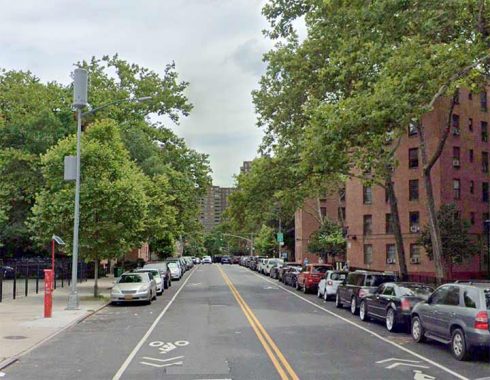
TIME once again to jump into the H.G. Wells Time Machine and head for some time other than now. This contraption is hard to keep around my apartment, especially with all the bookshelves. I could put it in storage, but some jabronie would make off with it and head for parts and periods unknown and I’d never see it again. After giving the dials a spin I wound up at Madison and Scammel Streets on the Lower East Side on July 14, 1941. I got funny looks because of my blue Mets hat with the orange bill.
In 2024, nothing except the Vladeck Park Houses, brand new in 1941 and without the lush street trees, exists today; the Vladeck Houses eventually expanded to take out the tenements and storefronts at left. Scammel Street, named for Revolutionary War commander Alexander Scammell (1747-1781. He was wounded while inspecting fortifications at Yorktown and was fired upon by British dragoons. The street, though, survived after a fashion as a pedestrian path in the Vladeck Houses complex, which was named for New York City Housing Authority boardmember Baruch Vladeck (1886-1938), who was also general manager of the Jewish Daily Forward.
The city infrastructure has changed since 1941. In the foreground is a Type 6 Bishop Crook, which was narrower than the usual Type 24 Crook, with simplified scrollwork. The pandant ornamentation held an Acorn white glass lamp fixture; these were in the process of changeover to Bell fixtures, one of which can be seen in the rear. The navy blue and white street signs hung on until the early 1960s for the most part. The Type 6 retained the ladder rest of its predecessor. The globular fire alarm indicators later gave way to cylinders which themselves became small red lights mounted on top of lamp fixtures shortly after the year 2000.
Note the Bell telephone signs; by 1940, not all households had phones yet. There are also ads for the New York Sun, of which there is a modern counterpart available by subscription. There was formerly a hard copy Sun newspaper, in which architecture author Francis Morrone favorably reviewed Forgotten NY the Book when it came out in 2006. In the distance at Corlears Hook looms the Williamsburg Bridge and a painted ad for the Bowery Savings Bank.

Despite more street trees, things look considerably blander in the this stretch of Madison in 2022, when this Street View photo was obtained. There is still a fire alarm where it was in 1941, marking the former location of Scammel Street. Another housing project blocks the view of the bridge.
As always, “comment…as you see fit.” I earn a small payment when you click on any ad on the site. Take a look at the new JOBS link in the red toolbar at the top of the page on the desktop version, as I also get a small payment when you view a job via that link.
[Actually the 1941 view is from Shorpy, a great old photo resource; thanks to Shorpy fan Vicki Metzger.]
3/25/24


5 comments
When I was a kid everytime I heard the Bowery Savings Bank jingle on the radio I would
imagine there was a bank down there run by winos
It’s probably due to photo angles or something, but Madison looks much wider in the old photo than today.
“The Sun” was the full name of the paper. Remember the afternoon paper, full name The World-Telegram and The Sun? Somehow that “The” before “Sun” annoyed me. People actually called it the Telegram.
The mergers of the New York newspapers continued as they continued to fold through the 1960’s. The penultimate was the short-lived “New York World-Journal-Tribune” which lasted for less than a year from 1966 to 1967.
Judging from the current photo, anyone wishing to document the old fire alarm pedestals should act fast. It appears that all the existing pedestals that are not the latest version are being replaced. Notice that the fire alarm box is equipped with a piece of conduit holding a solar panel. I assume that the old wired circuits for the alarms are being replaced with a cell phone like alarm system.
When I first worked at the Neponsit Home For The Aged I noted that there was a cast iron fire alarm pedestal right in front of the main entrance. It was the type that had the cast iron top extension having a provision for the orange globe light. The globe was gone but the socket and bulb were there. Looking at street view recently, I noticed that the pedestal had been replaced with a new one equipped with the solar panel. Looking further through Rockaway, it appears all the fire alarm pedestals had been replaced. It will be interesting to see if the replacement program includes the stainless steel pedestals installed in the 1970’s.